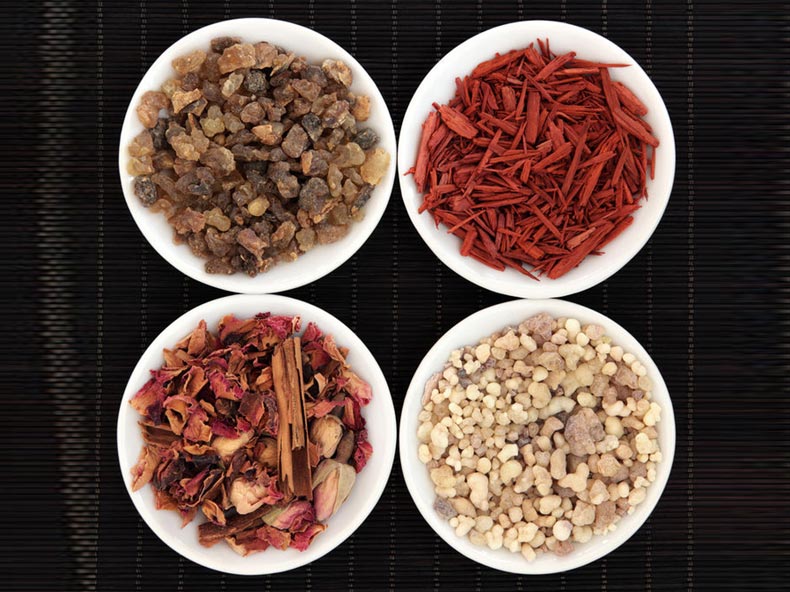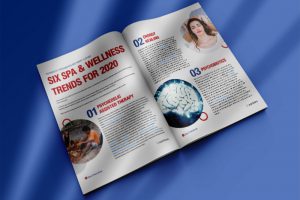
Research and technology are creating Next Generation Aromatherapy and leading the way for scent to be taken seriously as medicine.
Aromatherapy is hardly new. The practice of turning to scents and essential oils for their purported healing properties is probably thousands of years old, and though it’s often said that there is little solid scientific evidence for its efficacy, aromatherapy’s popularity continues to grow.
As we mentioned in our recent trends report, the Global Wellness Institute recently named “Aromatherapy 2.0: Scent as Medicine” as a trend to watch, citing many examples of how aromatherapy is moving into a new era, thanks to technological advancement and neuroscience studies. Among the examples cited was Aeroscena, a company based in the Cleveland Clinic’s Innovations Lab that has created a line of plant-based aromatherapeutics formulated to specifically treat symptoms like pain, nausea, and anxiety, with the guidance of a medical advisory board.
We wanted to further explore developments in aromatherapy, so we reached out Mark Kohoot, Aeroscena’s founder and CEO, to ask some questions about potential future research, applications, and developments.

Standardized and evidence based
Kohoot says next generation aromatherapy is rapidly moving toward a medical/clinical paradigm and an evidence-based practice.
“This is why we differentiate what we do as ‘clinical aromatherapy,’” he says. “It is standardized, evidence-based, quality controlled and clinically validated.” The focus is on testing and outcomes, so Aeroscena has partnered with medical practitioners and facilities, like the Moffitt Cancer Center, Nebraska Children’s Hospital, and Virginia Commonwealth University, where clinical research can be performed by third parties without bias.
The research landscape is changing dramatically
A lack of credible research is often cited as a concern when it comes to aromatherapy, but things are shifting. Kohoot points out that a quick search in PubMed now results in 1,401 studies that include the term “aromatherapy.”
“Historically,” he says, “aromatherapy has suffered from perception issues, and been lumped in with ‘alternative’ therapies, many of which are looked down upon by the medical community. Luckily, nurses — those on the front lines of patient care — have become amazing advocates and research partners.”
One research example he points to is Nebraska Children’s Hospital’s palliative care department: “The medical director, Dr. Meaghann Weaver, was interested in finding out how aromatherapy could help her patients, and liked that our inhalers provided a standardized form factor for use. She noted improvements across the board after adoption, and asked us to work with her on a pilot study by providing materials. The positive results of the study on pediatric pain, anxiety, and nausea were then published by Cambridge University last November in the journal Palliative and Supportive Care.”
Aeroscena also participated in research with Moffitt Cancer Center to examine the effect of aromatherapy on nausea and anxiety in patients undergoing chemotherapy at their infusion centers. “The results were positive here as well,” said Kohoot, with a 50%-80% reduction in nausea and anxiety achieved across all three centers. The reduction of both symptoms was maintained over the five-month course of treatment for the majority of study participants.
“Acceptance of and demand for aromatherapy in clinical environments continues to grow at a remarkable pace.”
How can aromatherapy be used in a wellness setting, like a spa, to create different results and outcomes?
Kohoot uses the example of a larger, more complex spa setting with multiple environments.
To create a relaxing atmosphere, the reception area can be scented with a formula based on constituent ingredients that have demonstrated anti-anxiety effects in clinical studies, he says.
“Then, the spa client could go to more than one area from reception for any number of treatments. While many likely hope to relax, some may prefer to feel more energized or focused.”
Aeroscena, he explains, creates formulas designed for these specific results using an efficacy-first model. “We first find the oils that have the best supporting scientific evidence for what we hope to achieve and then we take those oils to our master aromatherapist, who finds a combination and ratio of those oils also produces a pleasant scent.”
He goes on to say, “Many large spas also have gyms, pools, hydrotherapy circuits, luxurious locker rooms, and dedicated rooms reserved for yoga and the like. Whether spas want to uplift, energize, or relax clients, there is an all-natural, truly healthy option available to do just that.”
How aromatherapy is being used in hospitals and other healthcare settings
There are many areas of healthcare where aromatherapy is appropriate, says Kohoot, who cites chemotherapy infusion centers, dialysis centers, postoperative recovery rooms, birthing centers, and palliative care, among the examples.
“It’s also very useful in waiting rooms to decrease patient anxiety prior to treatment or consultation. This is especially true for dental offices, where malodors are common and patient dental anxiety is a real problem for practitioners, who then struggle with patient recall. A more pleasant, relaxing waiting room experience can create a positive feedback cycle that means less dental fear, and more returning patients who get the care they need.”
Developments involving aromatherapy and technologies, like AI and VR
Aeroscena is involved in some aspects of VR and AR, but “not what you’d think,” said Kohoot. They’re working with Johns Hopkins and Drexel University on the issue of nausea in children getting VR rehab. “The feeling of disembodiment that comes with floating in space often is accompanied by nausea and nobody likes cleaning that up.”
And, by now we’ve all read about the idea of enhancing movies and virtual worlds with scent.
Kohoot said, “Our best guess is that the gaming industry will work to use the smell of tires/gas/oil for racing games or something like that. However scents are so complex, it is hard to have a set of a few chemicals that can be mixed, like a cmyk printer, to make most scents. And, really, that sort of thing is going to be synthetic fragrances, more than aromatherapy.”
How aromatherapy will be used five or 10 years from now
“Aromatherapy has plenty of potential in terms of new applications and environments, especially when used in concert with technologies like AI and VR,” said Kohoot, “But one of the main changes we expect to see is the acceptance of aromatherapy as a drug, rather than an ‘alternative therapy.’”
He envisions successful research leading to more interest in standardized solutions for aromatherapy as an over the counter, and even prescription, drug to treat specific medical conditions.
“We also expect to see more research into essential oils as antiviral and antibacterial agents.”
 We’ve released our spa and wellness trends to watch for 2020. Sign up for Spa Executive’s newsletter and download the free report! CLICK HERE >>
We’ve released our spa and wellness trends to watch for 2020. Sign up for Spa Executive’s newsletter and download the free report! CLICK HERE >>
Spa Executive magazine is published by Book4Time, the world’s most innovative spa, salon, wellness, and activity management software. Learn more at Book4Time.com.



